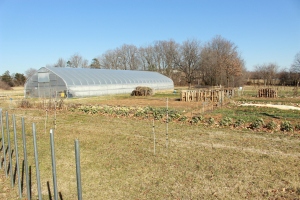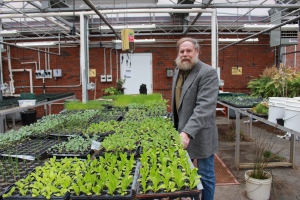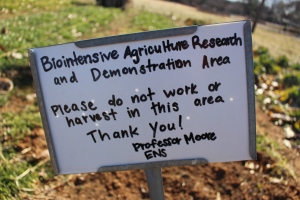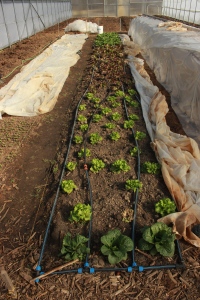Experiential learning is not hard to find on Elon University’s campus and the Environmental Studies Department is no exception. On most days of the week, one can find a number of professors rolling up their sleeves on Loy Farm with their students.
Loy Farm was purchased by the university in 2000 and was originally used for landscape equipment storage. It is located across from the South Oak Ave and Saddle Club Rd intersection just outside of campus.
When Dr. Steven Moore came to Elon in 2011 he saw a need for students to learn about the environment and local agriculture in a more direct way, so he started the AgroEcology Program and the space was converted into a student farm.
Today, Loy Farm is used for growing produce in rows and inside its recently renovated solar-powered greenhouse. It is also used as for student research and engagement.
Although those who are interested in Environmental Studies use Loy Farm frequently, professors and students from all disciplines have access to its resources.
According the Elon Website, “Humanities, social science and natural science courses all utilize the farm as an instructional tool, and it hosts the research projects of both students and professors.”
Because the field of environmental sustainability is always changing, Moore wants to use Loy Farm as a fluid model for sustainable and responsible farming. From chemical-free pest control methods to carbon-rich compost, everything about the farm it is sustainable.
“We focus on growing carbon crops for composting purposes so that we can minimize the unsustainable inputs that we have on the land,” Moore said. “Students also do a lot of research surrounding sustainable agriculture at Loy, which will have real-world implications.”
Loy Farm also exceeds every requirement to be deemed a Certified Organic Farm by the US Department Agriculture. According to Center For Sustainability at Aquinas College, “Organic farming typically requires 2.5 times more labor than conventional farming, but it yields ten times the profit.”
But, Moore is hardly worried about a profit. In an effort to support local agriculture, he makes sure everything that is harvested at Loy Farm goes right back to the Elon community.
“Students, professors, Mill Point Catering, Elon Campus Kitchen and Allied Churches all have access to what we harvest,” Moore said. “One hope for the future is that Loy Farm will eventually provide enough produce to supply the campus dining halls.”
Elon graduate Brett Evans was the garden manager at Loy during its full conversion to a student farm and was inspired by the project’s success. He decided to start his own small-scale, sustainable farm.
“I now have my own farm near Chapel Hill, and I continue to rely on Dr. Moore’s guidance,” Evans said.
Senior Allison Hren is the current garden manager at Loy Farm and is also very passionate about the project.
“Over the past few years, Loy Farm has taught me so much about biointensive agriculture, crop planning and planting, and all the odds and ends around owning a small, sustainable farm,” Hren said.
If students want to get involved at Loy Farm all they have to do is grab a shovel and get started.
“Everyone is welcome,” Hren said. “Loy needs the love.”
RESOURCES:
Consumer Resources. “Sustainable Farming.” Center for Sustainability at Aquinas College. Aquinas College, n.d. Web. 18 Feb. 2015.





This is a well-crafted photojournalism project. The quotes and information characterize the spirit of Dr. Moore and his passion for the potential of Loy Farms. The last line was a nice touch. Your photo subjects are well chosen, and help to the reader to visualize the story of Loy Farms.
The Loy Farms sign is a well-chosen subject for the first photo. It was a good idea to include the scenery and the road in the background. Compositionally, I like that the shot is angled, but I think that the photo would be even more effective if your stance was more closely aligned with the middle of the sign. The photo itself is very well-exposed.
The photo that features the greenhouse is also well-shot, but it could be improved by moving away from the poles along the right side. They are strong elements and they disrupt the balance of the photo. It seems that you also made an effort to use the rule of thirds here. This shot is also well-exposed.
In the third photo down, which I assume features Dr. Steven Moore, you made the right choice by showing him alongside his work. You also incorporated the rule of thirds here. The angle and perspective is well done, but it would have been interesting to see a shot with a lower angle in which Dr. Moore seems to stand taller in the photo. It would contribute to the idea of Dr. Moore as a knowledgeable leader. Keeping the plants visible would maintain the nice touch that you made to his characterization.
The shot of the sign is another example where you found a great subject for telling the story. It helps to characterize the Loy Farm project and Dr. Moore. I wonder if it would have been useful to back up the perspective a bit and include more of the field in the background while using the rule of thirds. On the other hand, making the shot close-up and mimicking the marker-drawn sign with a slightly crooked angle seems to add to the DIY character in the story.
The last shot is particularly nice to look at because of the great angle and very pleasant exposure. The alignment could have been slightly adjusted to perfect the perspective, but this shot generally gets it right. It continues to add character to the story of Loy Farms with its calming atmosphere. The high angle works, but I think that a shot with a slightly lower angle could have made the shot even more effective.
Good work, Joelle!
LikeLike